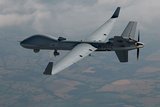Northrop Grumman wins NATO AGS contract
Northrop Grumman has announced that it has signed a $1.7 billion (€1.2 billion) contract for NATO’s Alliance Ground Surveillance (AGS) system. Operating under NATO command, AGS is expected to be the major data source for NATO’s system for Joint Intelligence, Surveillance and Reconnaissance (JISR). The company made the announcement 20 May, 2012.
According to Northrop Grumman, the contract is intended to provide for the purchase and initial operation and maintenance of five Block 40 Global Hawk UAVs equipped with an advanced ground surveillance radar sensor, the Multi-Platform Radar Technology Insertion Program (MP-RTIP). Under the contract, European industry contributors will be responsible for development and delivery of the transportable ground stations suitable for in-theatre support directly to commanders of deployed forces, mobile ground stations for close support to moving operations, and remote workstations for higher echelon commands.
Signed by the NATO Alliance Ground Surveillance Management Agency (NAGSMA) during the NATO 2012 Summit, the trans-Atlantic multinational contract supports NATO’s intelligence, surveillance and reconnaissance (ISR) requirements for multinational theater operations, peacekeeping missions and disaster relief efforts.
Under the contract, Northrop Grumman will be the prime contractor for the NATO AGS programme, and will build the Global Hawk air vehicle, supporting systems and payloads including the MP-RTIP radar, which is capable of detecting and tracking moving objects as well as providing radar imagery of target locations and stationary objects.
According to the company, the primary industrial team from the 13 nations will include Cassidian, Selex Galileo and Kongsberg, as well as leading European defense firms ICZ, ComTrade, BIANOR, Technologica, Zavod Za Telefonna Aparatura, Selex Elsag, Elettra Communications, UTI Systems and SES. The ground element, which provides real-time data, intelligence and target identification to commanders within and beyond line of sight, will be wholly produced by European industry, offering direct work in the programme for the participating nations.
NAGSMA was chartered in September 2009 to acquire the AGS core capability and is responsible for the procurement until it has reached full operational capability. The NATO-owned and operated AGS system is intended to support a broad range of missions, including protecting ground forces, border and maritime security, counter- and anti-terrorism, crisis management, peacekeeping and enforcement, and humanitarian assistance and natural disaster relief.
With its main operating base at Sigonella, Italy, NATO AGS will be co-located with the US Air Force Global Hawks and the US Navy Broad Area Maritime Surveillance unmanned aircraft systems, further advancing synergies across the three programmes in operational capability, life cycle logistics and sustainment.
More from Uncrewed Vehicles
-
![What's next for the Pentagon after the Replicator programme?]()
What's next for the Pentagon after the Replicator programme?
Although the Replicator initiative has made several accomplishments, there are still multiple gaps to plug across the US Department of Defense (DoD) and its services.
-
![Cummings Aerospace showcases Hellhound loitering munition designed for US Army’s LASSO programme (video)]()
Cummings Aerospace showcases Hellhound loitering munition designed for US Army’s LASSO programme (video)
Cummings Aerospace presented its turbojet-powered Hellhound loitering munition at SOF Week 2025, offering a man-portable solution aligned with the US Army’s LASSO requirements.
-
![SOF Week 2025: PDW unveils attritable FPV drone for SOF operations at scale]()
SOF Week 2025: PDW unveils attritable FPV drone for SOF operations at scale
PDW has revealed its Attritable Multirotor First Person View drone at SOF Week 2025, offering special operations forces a low-cost, rapidly deployable platform for strike and ISR missions, inspired by battlefield lessons from Ukraine.
-
![SOF Week 2025: Teledyne FLIR white paper provides guidance on reusable loitering munitions]()
SOF Week 2025: Teledyne FLIR white paper provides guidance on reusable loitering munitions
Teledyne FLIR is highlighting the emerging requirements for 'recoverable and re-usable' loitering munitions across the contemporary operating environment during this week’s SOF Week conference in Tampa, Florida.
-
![SOF Week 2025: Kraken Technology group debuts K3 Scout USV in North America]()
SOF Week 2025: Kraken Technology group debuts K3 Scout USV in North America
High-performance maritime industry player Kraken Technology Group, based in the UK, has used the SOF Week conference in Tampa, Florida this week to debut its K3 Scout uncrewed surface vessel (USV) to the North American market.
-
![Palladyne AI and Red Cat to demonstrate capabilities for autonomous drone swarms to the US military]()
Palladyne AI and Red Cat to demonstrate capabilities for autonomous drone swarms to the US military
Red Cat and Palladyne AI recently conducted a cross-platform collaborative flight involving three diverse heterogeneous drones.

























